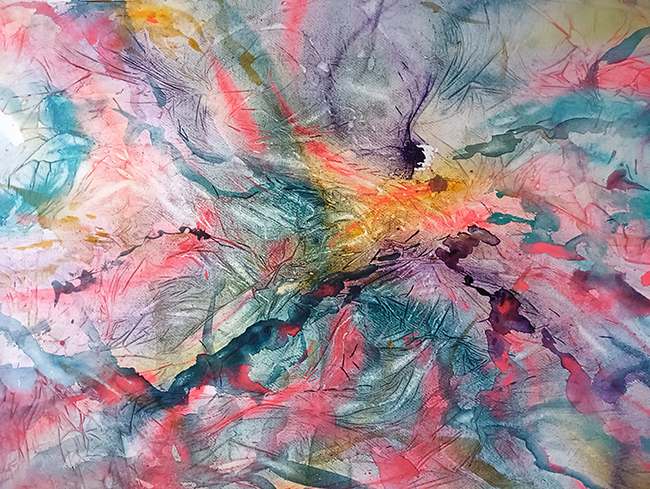David John Hilditch allows paint to have a life of its own, creating complex and abstract environments where ideas of reality can emerge and transform free from the moorings of time, space, and causality. This freedom is explored through the language of clouds in flux, hints of facial structures, abstract textures, and forms from nature. Inspired by the masters of figurative oil painting and the writings of modern Western philosophers, his watercolors and large-scale oils reflect on perception, impermanence, and identity in a way that is deep, engaging, and open to endless interpretation.

David was born in Wolverhampton in 1951, received his foundation in Birmingham, and earned a Fine Art Degree from Camberwell. Following a career teaching Art and Design, he now pursues an interest in philosophy and paints full-time from studios in London and Shropshire. His work builds up in many layers over time, starting with a turpsy underpainting, gradually building to impasto, and finishing with scumbles and glazes. His watercolors, consisting of multiple layers, exploit the fluidity of the medium. Close inspection of the work of the Old Masters reveals great freedom in the application of paint, capturing broader and deeper truths of reality. David believes that freely applied paint relates to a universal law that can spontaneously turn inanimate matter into infinite forms. Drawing on natural structures found in both micro and macro worlds, his paintings attempt to manifest this connection.
David Hilditch’s art is a journey into the abstract, where the boundary between the known and the unknown blurs, and viewers are invited to lose themselves in a sea of colors and forms. His approach to painting is methodical yet allows for spontaneous expression, a combination that creates works rich in texture and meaning. Each piece is a testament to his deep understanding of and connection to the materials he uses.
One of David’s significant works is “Watercolour L448,” a watercolor on Khadi paper, measuring 70x50cm. The piece showcases his technique of applying several wet layers, which are brought together when the surface dries. The interplay of colors and forms in this piece is striking, reflecting his fascination with how these elements meet, react, and create new life. Like his oil paintings, “Watercolour L448” draws inspiration from the micro and macro domains, allowing the medium to dictate its direction while David guides its flow.
David’s technique is rooted in the traditions of the Old Masters, yet he brings a modern sensibility to his work. His use of multiple layers and varied textures creates a sense of depth and complexity that draws viewers in, encouraging them to explore the subtleties of each piece. The layering process, which starts with a turpsy underpainting and builds to impasto, scumbles, and glazes, is intricate and reflects his deep respect for the medium.
In his watercolors, David exploits the fluidity of the medium to create works that are both spontaneous and controlled. The multiple layers of watercolor allow for a play of light and color that is unique to this medium. The final result is a vibrant, dynamic piece that captures the essence of his subjects while leaving room for interpretation.
David’s inspiration from natural structures found in both the micro and macro worlds is evident in his work. His paintings are attempts to manifest the connection between these natural structures and the broader truths of reality. This connection is further emphasized by his belief that freely applied paint relates to a universal law, capable of turning inanimate matter into infinite forms.
His philosophical approach to art is influenced by the writings of modern Western philosophers, and this influence is evident in the themes of perception, impermanence, and identity that run through his work. Each piece is a reflection on these themes, encouraging viewers to contemplate their own perceptions and the nature of reality.
David’s background in teaching Art and Design has also informed his practice. His understanding of art history and technique is evident in the precision and depth of his work. Yet, despite this precision, there is a sense of freedom and spontaneity in his paintings that speaks to his belief in the importance of allowing paint to have a life of its own.
Working from his studios in London and Shropshire, David continues to explore the possibilities of paint, pushing the boundaries of what can be achieved with this medium. His work is a testament to his dedication to his craft and his belief in the transformative power of art.
In conclusion, David John Hilditch’s art is a reflection of his deep understanding of and connection to the medium of paint. His works are rich in texture and meaning, inviting viewers to explore the interplay of colors and forms and contemplate the deeper truths of reality. Inspired by the masters of figurative oil painting and the writings of modern Western philosophers, his paintings are a journey into the abstract, where ideas of reality can emerge and transform free from the moorings of time, space, and causality. Through his intricate layering process and philosophical approach, David creates works that are both engaging and open to endless interpretation.

